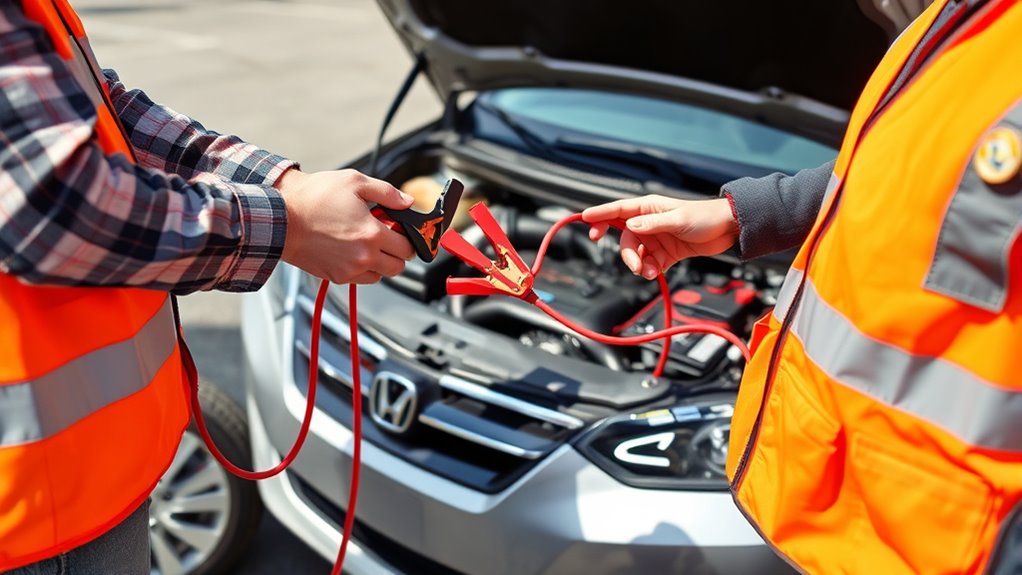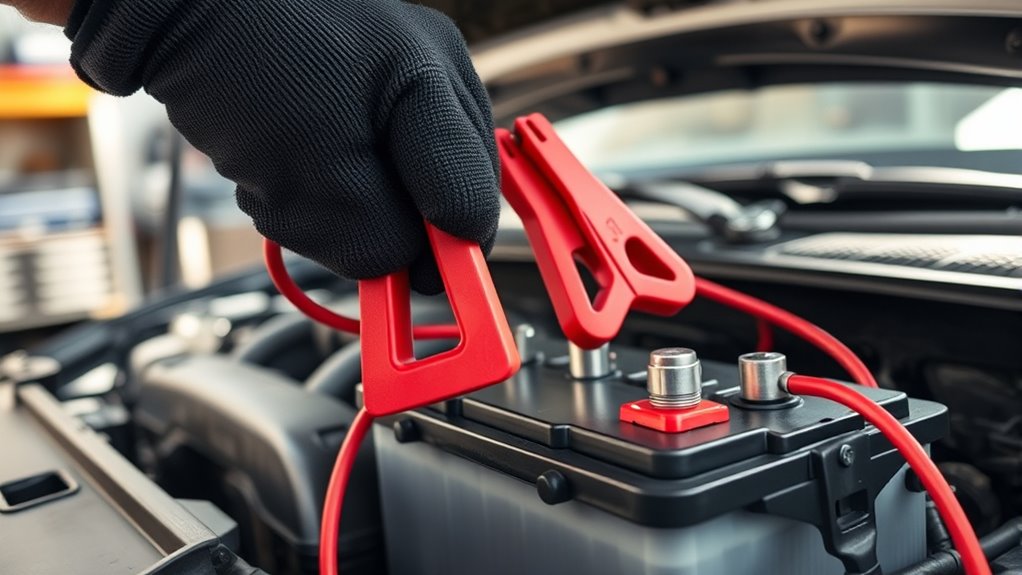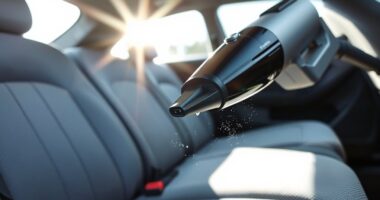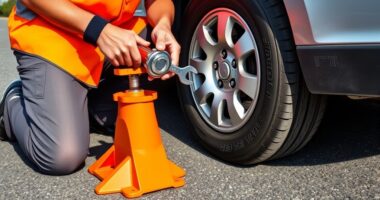To jump-start your car safely, make sure both vehicles are off and parked close, with parking brakes engaged. Connect the red clamp to the dead battery’s positive terminal, then to the good battery’s positive terminal. Attach the black clamp to the good battery’s negative terminal and the other to an unpainted metal surface on the dead car’s engine block. Start the working vehicle, wait a few minutes, then try to start the dead one. If successful, disconnect the cables in reverse order.
Key Takeaways
- Ensure both vehicles are off, parked close, and parking brakes engaged before connecting jumper cables.
- Attach the red clamp to the dead battery’s positive terminal, then the other red to the good battery’s positive terminal.
- Connect the black clamp to the good battery’s negative terminal, and attach the other black to an unpainted metal surface on the dead car’s engine.
- Start the working vehicle and let it run a few minutes before attempting to start the dead vehicle.
- Disconnect cables in the reverse order: black from ground, black from good battery, red from dead battery, then red from the good battery.

When your car battery dies unexpectedly, knowing how to jump-start it can save you time and help you get back on the road quickly. It’s a useful skill that ties into good battery maintenance and your overall emergency preparedness. Regularly checking your battery’s health, cleaning terminals, and making sure secure connections can prevent many dead battery situations. But even with proper maintenance, batteries can fail unexpectedly, especially in cold weather or after long periods of disuse. Being prepared with the right tools, like jumper cables, and knowing how to use them safely, guarantees you’re ready for such moments.
Before attempting a jump-start, make sure both cars are turned off, parked close enough for the cables to reach, and that the parking brake is engaged. Open the hoods and identify each battery’s positive and negative terminals, usually marked with a “+” or “-”. It’s essential to connect the cables correctly to avoid sparks or damage. Attach one red clamp to the positive terminal of the dead battery, then attach the other red clamp to the positive terminal of the working battery. Next, connect a black clamp to the negative terminal of the good battery, and finally, attach the other black clamp to a grounded, unpainted metal surface on the engine block of the dead car. This grounding step reduces the risk of sparks near the battery.
Ensure both cars are off, parked close, and parking brakes engaged before connecting jumper cables correctly.
Once the cables are securely connected, start the functioning vehicle and let it run for a few minutes. This allows the dead battery to receive some charge. Then, try starting your car. If it starts, let it run for a few minutes to help recharge the battery further. Carefully remove the cables in the reverse order—black from the grounded metal, black from the good battery, red from the dead battery, and finally, red from the good battery. Keep the engine running for a while to make sure the battery gets enough charge to hold on its own.
Jump-starting your car isn’t just about immediate trouble-shooting; it’s also part of ongoing battery maintenance and emergency preparedness. Regularly inspecting your battery and cables, and knowing how to handle a dead battery safely, can save you from roadside stress. Always keep your jumper cables in your car, and consider carrying a basic emergency kit. Being prepared means you can respond quickly and confidently when your car unexpectedly refuses to start, reducing frustration and avoiding potential hazards. Properly understanding these steps makes you more self-reliant and ready for any sudden battery failure. Additionally, understanding the essential oils for battery health can help maintain your vehicle’s electrical system in the long run.
Frequently Asked Questions
Can Jump-Starting Damage My Car’S Electronics?
Jump-starting your car can sometimes cause electronic damage if not done correctly. If you don’t follow proper procedures, it might lead to surges that harm sensitive electronics or worsen battery issues, potentially requiring battery repair. To avoid this, make sure you connect the jumper cables properly and use a compatible power source. Properly jump-starting helps protect your electronics and keeps your vehicle running smoothly without risking damage.
What Should I Do if the Jumper Cables Won’T Connect?
If the jumper cables won’t connect, first double-check proper cable placement on both batteries, ensuring the clamps grip securely on the terminals. If they still won’t connect, consider alternative jump start methods like using a portable jump starter or calling roadside assistance. Never force the cables, as this can cause damage. Staying calm and following these steps helps you safely jump-start your car without risking damage or injury.
Is It Safe to Jump-Start a Frozen Battery?
Jump-starting a frozen battery isn’t safe because cold weather effects can cause the battery to crack or leak, risking damage or injury. Instead, you should focus on proper battery maintenance before winter, like keeping it charged and insulated. If your battery is frozen, wait for it to thaw completely in a warm environment before attempting a jump-start. This prevents further damage and guarantees safe, effective recovery.
How Long Should I Let the Dead Battery Charge?
You should let the dead battery charge for about 5 to 10 minutes before attempting to start your car. This charging duration helps provide enough power for the battery to turn over. During this time, guarantee proper battery maintenance by checking connections and avoiding overcharging. If the engine doesn’t start after this period, you might need to reattach the jumper cables and charge a bit longer, or consider replacing the battery.
Can I Jump-Start a Motorcycle With Car Jumper Cables?
You can jump-start a motorcycle with car jumper cables, but you must prioritize motorcycle safety and verify battery compatibility. Check your motorcycle’s voltage and compare it with your car’s battery to avoid damage. Always connect the cables correctly—positive to positive, negative to negative—and keep the motorcycle off during connection. If unsure, consult your motorcycle’s manual or a professional to prevent any risks or damage.
Conclusion
Now that you know how to jump-start your car safely, you’re better prepared for those unexpected battery failures. Remember to always follow the proper steps and safety precautions to avoid accidents. Have you considered keeping a jumper cable set in your trunk, just in case? It’s a simple step that could save you time and hassle. Stay safe, stay prepared, and your car will be ready to go whenever you need it.









